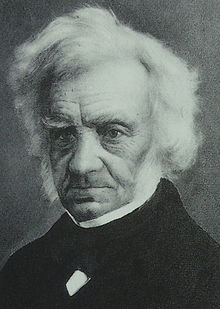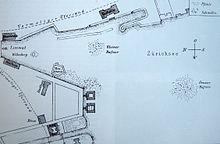Ferdinand Keller (archaeologist)
Ferdinand Keller (born December 24, 1800 in Marthalen , † July 21, 1881 in Zurich ) was a Swiss archaeologist and archaeologist. He founded prehistoric research in Switzerland.
life and work
Ferdinand Keller was the son of the goldsmith Heinrich Keller and his wife Anna, b. Hablützel. Ferdinand studied theology with ordination. In 1826 he pursued scientific studies at the Sorbonne and the Collège Royal in Paris. 1826–31 he was a private teacher in England and from 1831 to 1834 he was a teacher of English. Language at the Technical Institute (from 1834 industrial school) in Zurich. Then he lived as a privateer . Keller founded the Society for Patriotic Antiquities in Zurich in 1832 , which later became the Antiquarian Society in Zurich . 1847 awarded him the University of Zurich , the honorary doctorate .
In the winter of 1854/55, due to the unusually low water level at various lakes in the Swiss plateau, port facilities were expanded and attempts to reclaim land were made. During this work, remnants of wooden stakes, ceramics, bones and other remains of settlements were found in Meilen ( Meilen-Rorenhaab site ) on Lake Zurich . Based on these findings, Ferdinand Keller developed his theory of prehistoric pile dwellings that stood in the water of the shore zones. This led to a real pile-dwelling fever and the discovery of dozens of pile-dwelling settlements on the lakes of the Swiss plateau and on Lake Constance in the following decades. Keller gave important suggestions for the excavations in Vindonissa , which among other things led to Heinrich Meyer writing the history of the 11th and 21st Legion for the first time in 1853.
In the late 1860s, various prehistoric settlements in the city of Zurich - Kleiner and Grosser Hafner as well as at Bauschänzli and Alpenquai - were discovered during dredging in connection with the construction of the lake aqua facilities and were probably documented by Ferdinand Keller in 1868/69. In 1872, Keller wrote in his report to the Antiquarian Society in Zurich: “ We regarded the permission that the machine (excavator) was allowed to move on the large pot for about two days to dig deep furrows as a friendly perk. »His profile sketch of the lake bed, published in 1879, shows from top to bottom a 45 centimeter thick layer of stone, a cultivated layer (15 cm) as well as sand, mud and clay. Keller referred to a large number of piles lying in the lake bed. Further investigations followed on a small scale around the year 1883, whereby over 50 bronze and more than 100 stone ax blades are said to have come to light (the majority of the finds were lost).
With his pile-building theory, Keller became internationally famous in the archaeological field. His original theory, with its structures built exclusively on stilts in the water, has now been supplemented by the term wet-soil settlements .
Ferdinand Keller was an honorary member of the Berlin Society for Anthropology, Ethnology and Prehistory and, since 1880, a corresponding member of the Prussian Academy of Sciences . He published numerous writings, especially in the "Mitteilungen der Antiquarian Gesellschaft in Zürich".
Fonts (selection)
- The panorama of Zurich. Description of the mountains visible in Zurich's surroundings, together with a description of the ascent of the Tödiberges, which was carried out in 1837 . Orell, Füssli and Compagnie, Zurich 1840
- The Saracen invasion of Switzerland around the middle of the 10th century. In: Communications from the Antiquarian Society in Zurich, 1856 online at: e-rara.ch (platform for digitized prints from Swiss libraries)
- Archaeological maps of Zurich and Eastern Switzerland - online at: e-rara.ch (platform for digitized prints from Swiss libraries)
- The Lake Dwellings of Switzerland, and Other Parts of Europe. London 1866 digitized
literature
- Gerold Meyer von Knonau : Keller, Ferdinand . In: Allgemeine Deutsche Biographie (ADB). Volume 15, Duncker & Humblot, Leipzig 1882, pp. 563-568.
- Emil Vogt: Keller, Ferdinand. In: New German Biography (NDB). Volume 11, Duncker & Humblot, Berlin 1977, ISBN 3-428-00192-3 , p. 430 f. ( Digitized version ).
- Bernhard von Arx: The sunken villages. Ferdinand Keller and the invention of the pile dwelling . Unionsverlag, Zurich 2004
- Antiquarian society in Zurich (ed.): Pfahlbaufieber. From antiquarians, pile dwellers, antiquaries and pile dwelling myths. Contributions to "150 years of pile dwelling research in Switzerland", Chronos, Zurich 2004
- Kurt Altorfer : Ferdinand Keller. In: Historical Lexicon of Switzerland . May 19, 2006 .
Web links
- Literature by and about Ferdinand Keller in the catalog of the German National Library
- Works by and about Ferdinand Keller in the German Digital Library
Individual evidence
- ^ Kurt Altorfer: Ferdinand Keller. In: Historical Lexicon of Switzerland . May 19, 2006 , accessed June 14, 2019 .
- ^ Walter Drack : Zürcher Denkmalpflege, 6th report 1968/1969 . Directorate of Public Buildings of the Canton of Zurich (ed.), Zurich 1973, p.
| personal data | |
|---|---|
| SURNAME | Keller, Ferdinand |
| BRIEF DESCRIPTION | Swiss archaeologist and archaeologist |
| DATE OF BIRTH | December 24, 1800 |
| PLACE OF BIRTH | Marthalen |
| DATE OF DEATH | July 21, 1881 |
| Place of death | Zurich |


